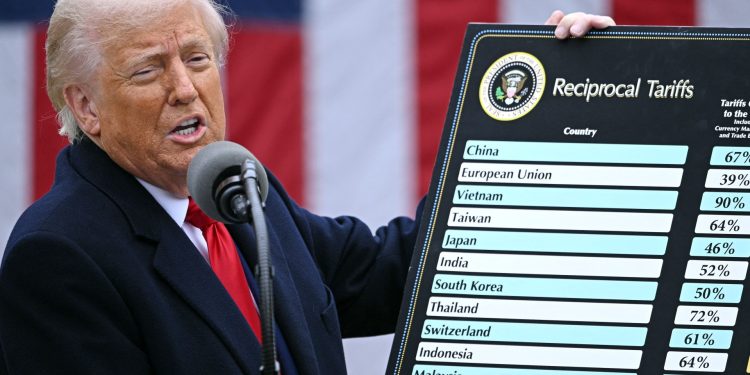Trump held up a reciprocal tariffs chart during his ‘Liberation Day’ address.
President Donald Trump on Wednesday announced a range of reciprocal tariffs targeting almost all countries that the United States trades with, taking a sledgehammer to Washington’s longstanding advocacy of free trade and globalisation.
Trump’s latest tariffs, which build on a series of similar steps he has taken since returning to office on January 20, are going to hit the countries with which Washington has large trade deficits, or that impose heavy tariffs on US goods. In 2023, the US imports were worth $1.1 trillion more than its exports; no other country has as large a trade deficit as the US.
Trump’s reciprocal tariffs also target countries like Syria, which has faced Israeli attacks since the overthrow of President Bashar al-Assad in December 2024, and Myanmar, which is reeling from earthquake damage amid a civil war. They also target economies already struggling to balance their books, depending on loans from the International Monetary Fund, such as Sri Lanka and Pakistan.
Here is how each country will specifically be targeted by Trump’s tariffs and the few sectors that are — for now — exempt from the penalties.
Trump announced the reciprocal tariffs in an executive order alongside an address in the Rose Garden at the White House on Wednesday. Trump had been describing April 2 as “Liberation Day”.
In the executive order, Trump said while the US trading policy has been built on the principle of reciprocity, taxes and barriers on US products by its trading partners had hurt the US.
The tariffs, he said, were a response. These reciprocal tariffs will come into effect on April 9.
During his address, Trump made the argument that the US is charging its trading partners with smaller tariffs compared with the tariffs and non-tariff barriers that the partners impose on the US.
But the effective tariff on China will actually be higher — and some countries will now be tariffed higher than the duties they levy on US imports. Chinese goods will face a 34 percent reciprocal tariff in addition to the 20 percent tariff that Trump imposed earlier, bringing the overall tariff on Chinese goods to 54 percent, close to his campaign promise of 60 percent. In 2024, China was the second-largest trading partner of the US.
The White House released an annexe of 57 target countries, territories and blocs which will face the increased tariffs. These include:
Yes. Apart from the 57 on the list announced on Wednesday, Trump has also imposed a flat 10 percent tariff on products coming from almost all the other trading partners of the US.
He did this by invoking the International Emergency Economic Powers Act of 1977.
Some of the leading countries that will face this 10 percent tariff rate on all exports to the US include:
What did Trump say?
These tariffs will come into effect on April 5.
While Canada and Mexico were not on the list of countries slapped with the latest tariffs, both US neighbours already face heavy tariffs.
Non-USMCA-compliant energy and potash face a 10 percent tariff. All other non-USMCA-compliant products from Mexico and Canada continue to face 25 percent tariffs.
The White House on Wednesday reaffirmed that the tariffs on Mexico and Canada remain in place.
The exempt products include copper, pharmaceuticals, semiconductors, lumber articles, energy products and certain critical minerals that are unavailable in the US.
On March 26, Trump signed an executive order imposing 25 percent tariffs on auto imports and certain automobile parts. No additional tariffs on these products were announced on Wednesday.









